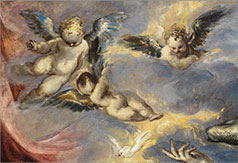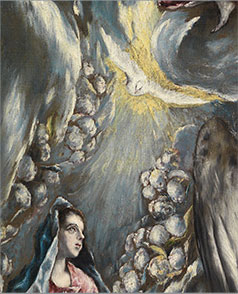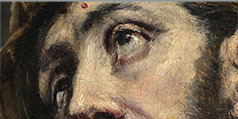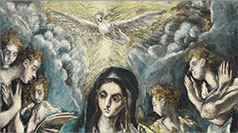PROJECT EXHIBIT
Dates: From 10 January to 2 March 2014Venue: Balcony. First Floor. Direct access from Main Hall. Museo Thyssen-Bornemisza, Madrid.
Visit: Free entry. Open Tuesdays to Sundays from 10.00 to 19.00; Mondays from 12.00 to 16.00.
 Fig. 1
Fig. 1The Annunciation, ca. 1576.
Oil on canvas. 117 x 98 cm. Detail of the cherubs and the dove symbolising the Holy Ghost. Madrid, Museo Thyssen-Bornemisza. Cat. no. 172 (1975.34).
 Fig. 2
Fig. 2The Annunciation, ca. 1596-1600.
Oil on canvas. 114 x 67 cm. Detail of the Virgin and cloud of glory. Madrid, Museo Thyssen-Bornemisza. Cat. no. 171 (1954.1).
 Fig. 3
Fig. 3Christ with the Cross, ca. 1587-1596
Oil on canvas. 66 x 52.5 cm. Detail of Christ's face. Madrid, Museo Thyssen-Bornemisza. Cat. no. 169 (1930.28).
 Fig. 4
Fig. 4The Immaculate Conception, ca. 1608-1614.
Oil on canvas. 108 x 82 cm. Detail of the Virgin's face, the dove and the angels. Madrid, Museo Thyssen-Bornemisza. Cat. no. 170 (1930.29).
THE PROJECT
On the occasion of the 400th anniversary of the death of El Greco (Candia, 1541-Toledo, 1614), we are pleased to present the results of the technical study of the works in the Thyssen-Bornemisza Collection.
By using chemical analyses, X-rays and infrared imaging, we are able to conduct research that sheds new light on the artist’s material and conceptual evolution in works from the two phases of his career under study—his years in Italy and in Spain—over the course of approximately two decades.
On the occasion of the 400th anniversary of the death of El Greco (Candia, 1541-Toledo, 1614), we are pleased to present the results of the technical study of the works in the Thyssen-Bornemisza Collection.
By using chemical analyses, X-rays and infrared imaging, we are able to conduct research that sheds new light on the artist’s material and conceptual evolution in works from the two phases of his career under study—his years in Italy and in Spain—over the course of approximately two decades.
The results of this research confirm the development of his formal and material evolution from an early period conditioned and influenced by the Italian masters—as we can clearly see in the architectural composition revealed by X-rays and infrared imaging—to his Spanish phase, when underdrawings all but disappeared from his paintings, his brushstrokes were looser and more subjective, and he combined impasto and glazing in no apparent order. The work of his final years is the culmination of an unmistakably personal style characterised by elongated figures blurred with Impressionist touches, a reflection of El Greco’s intellectual and technical maturity.
EL GRECO AT THE MUSEO THYSSEN-BORNEMISZA
El Greco is represented at the Museo Thyssen-Bornemisza by four works which clearly illustrate how strongly this artist appealed to the founders of the private collection that led to the creation of the Madrid museum. The other artists featured in this magnificent collection tend to be represented by only one or two paintings, making El Greco an exception in this context. The fascination that Heinrich Thyssen-Bornemisza (1875-1947), initiator of the collection, felt for El Greco was evident from the moment of the collection’s formation and first acquisitions. In this respect the influence of the historian August L. Mayer, an expert on the painter and Heinrich Thyssen’s adviser in those years, cannot be overestimated. For example, four El Greco works were included in the first exhibition of the Thyssen-Bornemisza Collection, known as the Sammlung Schloss Rohoncz, which was held at the Neue Pinakothek in Munich in 1930. By 1937, just seven years later, the number of El Greco paintings had risen to six. The catalogue of the collection published that year included two versions of the Mater Dolorosa, Portrait of a Young Gentleman, Christ with the Cross [Cat. 169 (1930.28)], The Immaculate Conception [cat. 170 (1930.29)] and a Last Supper [Cat. 17 (1934.5)]. The latter, currently on display at the museum, is now attributed to an anonymous Venetian artist. This fixation on one particular painter was not in keeping with the general tenor of the collection, and as time went by, particularly after Heinrich Thyssen passed away, some of the pieces were sold or attributed to other artists. A few of these works from the early days of the collection—specifically, the two paintings of the Virgin Mary and the portrait—never reached the Madrid museum, but Christ with the Cross and The Immaculate Conception both hang there today, as does the aforementioned Last Supper. El Greco's presence in the collection was subsequently reinforced in 1954, thanks to Hans Heinrich Thyssen, when two outstanding new acquisitions were made, both on the theme of the Annunciation. The first, a late painting dated circa 1596-1600, was purchased in 1954 [Cat. 171 (1954.1)]. The second one, painted in Italy circa 1576 and therefore pertaining to the artist's early period, was added in 1975 after being acquired from the Corsini Collection in Florence [Cat. 172 (1975.34)].
The four canvases currently on display at the museum document important milestones in El Greco's career. Of the two Annunciations, the earliest one is unique in Spanish collections due to its exquisite quality and the fact that paintings from his Italian period are scarce in Spain. In addition to being a fine example of how El Greco borrowed certain elements from other artists and made them his own, this oil painting also anticipates devices that he used in his later years, such as the cloud of glory and cherubs [Fig. 1]. The other Annunciation evidences the clearly defined style that characterised his final period [Fig. 2] and is a highly refined smaller version of the magnificent work he painted for the Colegio de Doña María de Aragón. The Annunciation was one of El Greco’s favourite themes, depicted time and time again throughout his career, and these two paintings offer visitors an extraordinary insight into the dramatic evolution of the artist's lines and composition through a single theme.
In Christ with the Cross we see a prototype of a pious image which in this case was taken from the Passion. Here, El Greco establishes an emotional connection with the viewer through the face and, above all, the hands and the eyes with their radiant gaze, one of his signature compositional features [Fig. 3]. Finally, in The Immaculate Conception [Fig. 4] we find evidence of the participation of a member of El Greco’s workshop, his son Jorge Manuel. This canvas is the work of two hands: the son’s is evident in the execution of the landscape with Marian symbols, while that of the father is most apparent in parts of the figure. It is an interesting painting for two reasons, the interpretation of the theme and the way in which it reflects two distinct sensibilities, as visitors to the museum will clearly see.
Mar Borobia
El Greco is represented at the Museo Thyssen-Bornemisza by four works which clearly illustrate how strongly this artist appealed to the founders of the private collection that led to the creation of the Madrid museum. The other artists featured in this magnificent collection tend to be represented by only one or two paintings, making El Greco an exception in this context. The fascination that Heinrich Thyssen-Bornemisza (1875-1947), initiator of the collection, felt for El Greco was evident from the moment of the collection’s formation and first acquisitions. In this respect the influence of the historian August L. Mayer, an expert on the painter and Heinrich Thyssen’s adviser in those years, cannot be overestimated. For example, four El Greco works were included in the first exhibition of the Thyssen-Bornemisza Collection, known as the Sammlung Schloss Rohoncz, which was held at the Neue Pinakothek in Munich in 1930. By 1937, just seven years later, the number of El Greco paintings had risen to six. The catalogue of the collection published that year included two versions of the Mater Dolorosa, Portrait of a Young Gentleman, Christ with the Cross [Cat. 169 (1930.28)], The Immaculate Conception [cat. 170 (1930.29)] and a Last Supper [Cat. 17 (1934.5)]. The latter, currently on display at the museum, is now attributed to an anonymous Venetian artist. This fixation on one particular painter was not in keeping with the general tenor of the collection, and as time went by, particularly after Heinrich Thyssen passed away, some of the pieces were sold or attributed to other artists. A few of these works from the early days of the collection—specifically, the two paintings of the Virgin Mary and the portrait—never reached the Madrid museum, but Christ with the Cross and The Immaculate Conception both hang there today, as does the aforementioned Last Supper. El Greco's presence in the collection was subsequently reinforced in 1954, thanks to Hans Heinrich Thyssen, when two outstanding new acquisitions were made, both on the theme of the Annunciation. The first, a late painting dated circa 1596-1600, was purchased in 1954 [Cat. 171 (1954.1)]. The second one, painted in Italy circa 1576 and therefore pertaining to the artist's early period, was added in 1975 after being acquired from the Corsini Collection in Florence [Cat. 172 (1975.34)].
The four canvases currently on display at the museum document important milestones in El Greco's career. Of the two Annunciations, the earliest one is unique in Spanish collections due to its exquisite quality and the fact that paintings from his Italian period are scarce in Spain. In addition to being a fine example of how El Greco borrowed certain elements from other artists and made them his own, this oil painting also anticipates devices that he used in his later years, such as the cloud of glory and cherubs [Fig. 1]. The other Annunciation evidences the clearly defined style that characterised his final period [Fig. 2] and is a highly refined smaller version of the magnificent work he painted for the Colegio de Doña María de Aragón. The Annunciation was one of El Greco’s favourite themes, depicted time and time again throughout his career, and these two paintings offer visitors an extraordinary insight into the dramatic evolution of the artist's lines and composition through a single theme.
In Christ with the Cross we see a prototype of a pious image which in this case was taken from the Passion. Here, El Greco establishes an emotional connection with the viewer through the face and, above all, the hands and the eyes with their radiant gaze, one of his signature compositional features [Fig. 3]. Finally, in The Immaculate Conception [Fig. 4] we find evidence of the participation of a member of El Greco’s workshop, his son Jorge Manuel. This canvas is the work of two hands: the son’s is evident in the execution of the landscape with Marian symbols, while that of the father is most apparent in parts of the figure. It is an interesting painting for two reasons, the interpretation of the theme and the way in which it reflects two distinct sensibilities, as visitors to the museum will clearly see.
Mar Borobia
